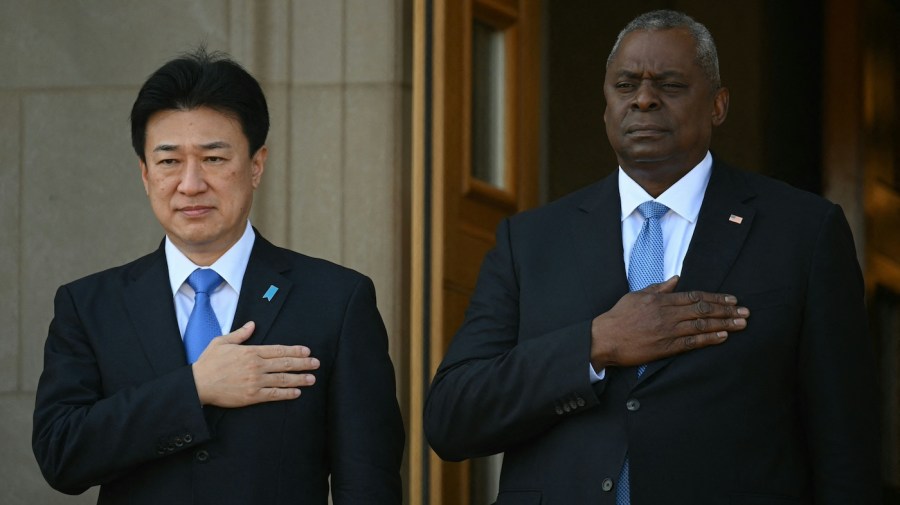Secretary of Defense Lloyd Austin was in Seoul in November for the 55th U.S.-Republic of Korea Security Consultative Meeting. The annual summit is a reminder of how deep America’s links to the Indo-Pacific region go; more than 300,000 South Korean personnel served in the Vietnam War, and 5,000 lost their lives. Austin also used his visit to hold a trilateral meeting with Shin Wonsik, Korea’s minister of national defense, and Minoru Kihara, Japan’s recently appointed defense minister, and a major agenda item was the future of Taiwan.
Korea, Japan, Taiwan: these are commitments that reach back almost as far as living memory. American forces have been in Japan since 1945 and Korea the same length of time, with a brief hiatus between 1949 and 1950. Today, U.S. Forces Korea comprises 23,500 personnel, and U.S. Forces Japan has 50,000 men and women under arms. American soldiers were withdrawn from Taiwan in 1979, but a handful of special forces and marines were reinserted by President Trump some time before 2020.
In 2011, then-Secretary of State Hillary Clinton wrote an article in Foreign Policy entitled “America’s Pacific Century.” This signaled the U.S. “pivot to Asia,” a rebalancing of its strategic focus towards the East and away from Europe and, to an extent, the Middle East. Now, with China no longer an arm’s-length partner but the most likely global adversary, America’s game plan is having to come into much sharper focus.
Earlier this year, the CIA reported that Xi Jinping, the Chinese president, had instructed his military leadership to be ready to take action against Taiwan by 2027. Xi has made the “reunification” of the island with mainland China a symbolic priority of his presidency, and while his “preference” is said to be for a peaceful process, he has not set aside the option of a forcible seizure.
The U.S. cannot regard this with equanimity. Not only does it have certain obligations under the Taiwan Relations Act of 1979 (though these fall short of a requirement to intervene militarily), China’s annexation of Taiwan would have massive economic repercussions, as the island produces 60 percent of the world’s semiconductors, and 90 percent of the most advanced microchips.
Over the last 10 years, Japan has quietly transformed its military capability and stance. Its post-war constitution was drawn up to make future aggression virtually impossible, but some of the most extreme strictures have been gradually loosened. In 2013, the nationalist Prime Minister Shinzo Abe, who was assassinated last summer, issued Japan’s first national security strategy, and in 2015 his government commissioned the first of two Izumo-class “helicopter-carrying destroyers,” effectively a small aircraft carrier capable of supporting at least 12 Lockheed Martin F-35B Lightning multi-role fighter aircraft.
This latter capability was not widely publicized, but Japan now effectively has a carrier fleet with an ability to project military power over much greater distances than ever conceived under its constitution. Over the next five years, Japan’s defense budget will double, putting the country’s expenditure around the 2 percent of GDP benchmark observed by NATO, and not far behind the 2.5 percent which Taiwan and South Korea spend. It has also agreed to cooperate with the UK and Italy in producing the Global Combat Aircraft Programme, which will enter service in 2035.
This is a positive step. With the U.S. significantly stretched in military terms, the UK struggling to maintain armed forces with full-spectrum capability and NATO member states still reluctant to fulfill their spending commitments, Japan stepping up and playing a greater security role in the Pacific would be enormously welcome. No one seriously expects the country to go an imperialist rampage or threaten the sovereignty of its neighbors. Bluntly, however, the West needs Japan.
This will occasion some conceptual and intellectual challenges and changes to the way we imagine Japan. A 2021 poll showed 84 percent of Americans had a favorable view of Japan, but only 1 percent regarded Japan as the U.S.’s principal security partner. While London chases the quicksilver of the “special relationship” and Israel has (for now) an entrenched position in the affections of the Beltway establishment, there is an opportunity for Japan to become one of the U.S.’s most useful and stalwart allies in the critical region.
The United States needs a president who can create this new strategic narrative and integrate it into a coherent global policy. In particular, this will require the U.S. and Japan to settle the issue of Okinawa, home of the III Marine Expeditionary Force. Facilities on the island are being substantially upgraded, but there is intense local opposition, both to the new development and to the U.S. presence in general.
Washington knows it cannot do everything. Even with the more outward-looking Biden administration, there is neither capability nor desire to police the world and impose a Pax Americana. But as the preeminent superpower, the U.S. has global interests and needs global reach.
The most effective way it can achieve this is through security partnerships. Japan is ready to take a more substantial role in international affairs, and should fit hand-in-glove with America. Each country now needs to make sure it is psychologically prepared, as the 80th anniversary of Imperial Japan’s surrender on the deck of the U.S.S Missouri in Tokyo Bay approaches in 2025. What better occasion to acknowledge the past and recognize a major transition in the partnership between the two countries?
Eliot Wilson is a freelance writer on politics and international affairs. He was senior official in the U.K. House of Commons from 2005 to 2016, including serving as a clerk of the Defence Committee and secretary of the U.K. delegation to the NATO Parliamentary Assembly.
